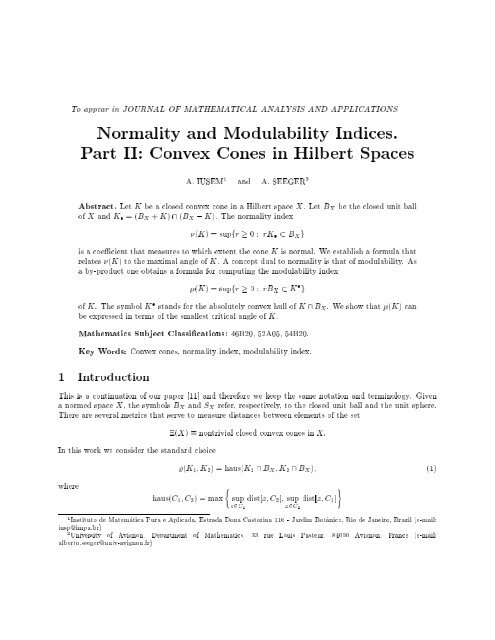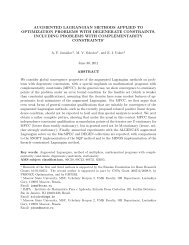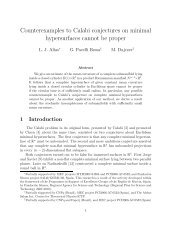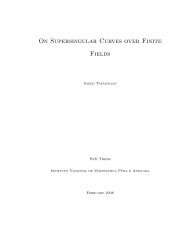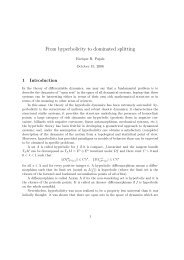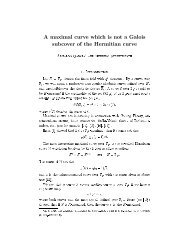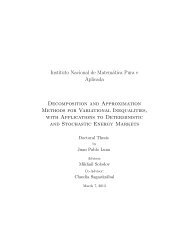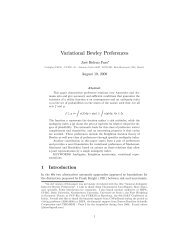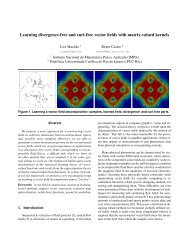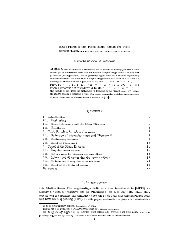Convex Cones in Hilbert Spaces
Convex Cones in Hilbert Spaces
Convex Cones in Hilbert Spaces
You also want an ePaper? Increase the reach of your titles
YUMPU automatically turns print PDFs into web optimized ePapers that Google loves.
Toappear<strong>in</strong>JOURNALOFMATHEMATICALANALYSISANDAPPLICATIONS<br />
PartII:<strong>Convex</strong><strong>Cones</strong><strong>in</strong><strong>Hilbert</strong><strong>Spaces</strong> NormalityandModulabilityIndices.<br />
ofXandK=(BX+K)\(BXK).Thenormality<strong>in</strong>dex Abstract.LetKbeaclosedconvexcone<strong>in</strong>a<strong>Hilbert</strong>spaceX.LetBXbetheclosedunitball A.IUSEM1andA.SEEGER2<br />
aby-productoneobta<strong>in</strong>saformulaforcomput<strong>in</strong>gthemodulability<strong>in</strong>dex isacoecientthatmeasurestowhichextenttheconeKisnormal.Weestablishaformulathat relates(K)tothemaximalangleofK.Aconceptdualtonormalityisthatofmodulability.As (K)=supfr0:rKBXg<br />
beexpressed<strong>in</strong>termsofthesmallestcriticalangleofK. ofK.ThesymbolKstandsfortheabsolutelyconvexhullofK\BX.Weshowthat(K)can (K)=supfr0:rBXKg<br />
KeyWords:<strong>Convex</strong>cones,normality<strong>in</strong>dex,modulability<strong>in</strong>dex. MathematicsSubjectClassications:46B20,52A05,54B20.<br />
Thisisacont<strong>in</strong>uationofourpaper[11]andthereforewekeepthesamenotationandterm<strong>in</strong>ology.Given 1Thereareseveralmetricsthatservetomeasuredistancesbetweenelementsoftheset<br />
anormedspaceX,thesymbolsBXandSXrefer,respectively,totheclosedunitballandtheunitsphere. Introduction<br />
Inthisworkweconsiderthestandardchoice Ì(X)nontrivialclosedconvexcones<strong>in</strong>X:<br />
where haus(C1;C2)=maxsup %(K1;K2)=haus(K1\BX;K2\BX); z2C1dist[z;C2];sup z2C2dist[z;C1] (1)<br />
iusp@impa.br) alberto.seeger@univ-avignon.fr) 1InstitutodeMatematicaPuraeAplicada,EstradaDonaCastor<strong>in</strong>a110-JardimBotanico,RiodeJaneiro,Brazil(e-mail: 2UniversityofAvignon,DepartmentofMathematics,33rueLouisPasteur,84000Avignon,France(e-mail:
follow<strong>in</strong>gtwoconcepts: dierentfromf0ganddierentfromthewholespaceX.Forthesakeofcompleteness,werecallalsothe satisfy<strong>in</strong>gK+KKandR+KK.Say<strong>in</strong>gthataconvexconeKisnontrivialsimplymeansthatKis dist[x;C]referstothedistancefromxtothesetC.ByaconvexconeweunderstandanonemptysetK standsfortheclassicalPompeiu-HausdordistancebetweentwoboundedclosednonemptysetsC1;C2,and<br />
Denition1.LetKbeaconvexconeK<strong>in</strong>anormedspaceX.Onesaysthat (a)Kisnormalifthereisaconstant>0suchthat (b)Kismodulableifthereisaconstant>0suchthat anyx2Xisexpressible<strong>in</strong>theformx=uv (kuk+kvk)ku+vkforallu;v2K: (2)<br />
Wearetak<strong>in</strong>gk(u;v)k=kuk2+kvk2 withu;v2Ksatisfy<strong>in</strong>gk(u;v)kkxk:<br />
befoundfor<strong>in</strong>stance<strong>in</strong>[12,14,19,22].Theconceptofnormalityisalsoclassicalanddoesn'tneedfurther nouniversalagreementwithrespecttotheterm<strong>in</strong>ology.Othernamesfortheconceptofmodulabilitycan isacceptable.Modulabilityisafundamentalconceptofthetheoryofconvexcones.Unfortunately,thereis 1=2;butanyequivalentnorm<strong>in</strong>theCartesianproductXX<br />
Theorem1.LetKbeaconvexconeK<strong>in</strong>anormedspaceX.Then, justication;seefor<strong>in</strong>stancethebooks[4,19,22]orthepioneer<strong>in</strong>gworksbyKre<strong>in</strong>andcollaborators[3,15].<br />
(a)KisnormalifandonlyifK=(BX+K)\(BXK)isbounded. Thenexttheoremisacomb<strong>in</strong>ationofseveralsources.Wetakethisresultforgranted.<br />
(b)KismodulableifandonlyifK=co[(K[K)\BX]isaneighborhoodoftheorig<strong>in</strong>.<br />
andthemodulability<strong>in</strong>dex Oneofthema<strong>in</strong>issuesofthispaperconcernsthepracticalcomputationofthenormality<strong>in</strong>dex<br />
(K)=supfr0:rBXKg (K)=supfr0:rKBXg (3)<br />
previouswork[11].Itisnotalwayseasytocomputetheright-handsides<strong>in</strong>(3)and(4).Theevaluationof ofanontrivialclosedconvexconeK.Themean<strong>in</strong>gsofthese<strong>in</strong>dicesareexpla<strong>in</strong>ed<strong>in</strong>fulllength<strong>in</strong>our thesetsKandKisalreadyadiculttaskbyitself.Thema<strong>in</strong>meritofthepresentpaperisshow<strong>in</strong>gthat (4)<br />
isexpressible<strong>in</strong>termsofthesmallestcriticalangleofK. Tobemoreprecise,weshowthat(K)canbeexpressed<strong>in</strong>termsofthemaximalangleofK,whereas(K) (K)and(K)admitniceandsimplecharacterizationformulaswhentheunderly<strong>in</strong>gspaceXis<strong>Hilbert</strong>.<br />
dimensional<strong>Hilbert</strong>space: ity.ThepurposeofSection4isestablish<strong>in</strong>gthefollow<strong>in</strong>gtopologicalresults<strong>in</strong>thecontextofan<strong>in</strong>nite i)WithrespecttothetruncatedPompeiu-Hausdormetric%,thepo<strong>in</strong>tedelementsofÌ(X)don'tform Anotherthemediscussed<strong>in</strong>thispaperhastodowiththel<strong>in</strong>kexist<strong>in</strong>gbetweenpo<strong>in</strong>tednessandnormal-<br />
openset.Equivalently,theunpo<strong>in</strong>tedelementsofÌ(X)don'tformaclosedset. 2
Tothebestofourknowledge,theabovedensityresultisnew.Byus<strong>in</strong>gadualityargument,weestablish alsoal<strong>in</strong>kbetweenalmostreproducibilityandmodulability. ii)Bycontrast,theabnormalelementsofÌ(X)doformaclosedset.Infact,thesetofabnormalelements ispreciselythe%-closureofthesetofunpo<strong>in</strong>tedelementsofÌ(X).<br />
Asmentioned<strong>in</strong>the<strong>in</strong>troduction,thepracticalcomputationofthecoecient(K)oerssometimesaserious challenge.Alleorts<strong>in</strong>characteriz<strong>in</strong>g(K)bymeansofalternativeformulasarenottobedespised.The 2nexttheoremsuggestsconsider<strong>in</strong>gtheexpression<br />
APrelim<strong>in</strong>aryFormulaforComput<strong>in</strong>g(K)<br />
<strong>in</strong>advancethedistancefunctiondist[;K]. astoolforevaluat<strong>in</strong>g(K).Ofcourse,thecomputationofthe<strong>in</strong>mum(5)isgreatlysimpliedifoneknows (K)=<strong>in</strong>f kzk=1maxfdist[z;K];dist[z;K]g (5)<br />
<strong>in</strong>sofar. Theorem2.ForanontrivialconvexconeK<strong>in</strong>anormedspaceX,onehas Theterm(K)appearsalready<strong>in</strong>references[5]and[9],butnoconnectionwith(K)hasbeenmade<br />
Weclaimthat Proof.Westartbyprov<strong>in</strong>gthe<strong>in</strong>equality(K)(K).Assumethat(K)>0,otherwisewearedone. (BX+K)\(BXK)[(K)]1BX: (K)=(K): (6)<br />
Takeanonzerovectorx<strong>in</strong>theabove<strong>in</strong>tersection.S<strong>in</strong>ce x2BX+K=)dist[x;K]1; (7)<br />
dist[;K],onegets onehasmaxfdist[x;K];dist[x;K]g1:Inviewofthepositivehomogeneityofthedistancefunction (K)maxdistx x2BXK=)dist[x;K]1;<br />
kxk;K;dist<br />
(K)(K).Ababsurdo,supposethat Thisprovesthatxbelongstotheright-handsideof(7)asneeded.Wenowtakecareofthereverse<strong>in</strong>equality kxk;K1x<br />
kxk:<br />
forsomes>0.Wemustarrivetoacontradiction.Take"2]0;s[andndavectorz"2Xsuchthat (BX+K)\(BXK)[(K)+s]1BX kz"k=1; (8)<br />
maxfdist[z";K];dist[z";K]g
Thecondition(10)impliesthat<br />
S<strong>in</strong>ceKisaconvexcone,anelementaryrearrangementyields z"2((K)+")BXK: z"2((K)+")BX+K;<br />
Inviewof(8)and(9),onegets<strong>in</strong>suchacase [(K)+"]1z"2(BX+K)\(BXK):<br />
contradict<strong>in</strong>gthefactthat"
<strong>in</strong>Section4. ofagivenofK2Ì(X).Theleast-distanceproblem(12)isof<strong>in</strong>terestforitselfandwillbestudied<strong>in</strong>detail<br />
Corollary3.IfKisanontrivialclosedconvexcone<strong>in</strong>a<strong>Hilbert</strong>spaceX,then(K)nor(K). isthelargestnonexpansivemapthatvanishesexactlyovertheabnormalelementsofÌ(X). Thenextcorollaryisrecordedforthesakeoflateruse.Notice,parenthetically,thatnor:(Ì(X);%)!R<br />
thepo<strong>in</strong>twisemaximalityofnor()amongallthenonexpansivemapson(Ì(X);%)thatvanishexactlyover theabnormalelementsofÌ(X). Proof.IfXisa<strong>Hilbert</strong>space,thendand%are<strong>in</strong>factidentical.ItsucesthentoapplyCorollary1and<br />
3.1Compar<strong>in</strong>g(K)and(K) Anumber>0satisfy<strong>in</strong>gthe<strong>in</strong>equality(2)iscalledanormalityconstantofK.Thebestpossible 3 TheBestNormalityConstantandtheAngularCoecient<br />
normalityconstantofKisofcourse(K)= Thenumber(K)2[0;1]canbeusedasatoolforquantify<strong>in</strong>gthedegreeofnormalityofK. (u;v)6=(0;0)ku+vk<br />
Thepurposeofthissectionistocompare(13)withthemuchsimplerexpression u;v2K <strong>in</strong>f kuk+kvk: (13)<br />
momenttothe<strong>in</strong>terpretationofthecoecient(K).First,westate: Wehavedividedby2<strong>in</strong>theright-handsideof(14)justtomakesurethat(K)2[0;1]:Weshallcome<strong>in</strong>a (K)= u;v2K\SXu+v <strong>in</strong>f 2: Proposition1.LetKbeanontrivialconvexcone<strong>in</strong>anormedspaceX.Then<br />
them<strong>in</strong>imizationproblem(14).Thissimpleobservationshowsthesecond<strong>in</strong>equality<strong>in</strong>(15).Therelation Proof.Ifoneaddstheconstra<strong>in</strong>tskuk=1andkvk=1<strong>in</strong>thefeasiblesetof(13),thenonearrivesat 12(K)(K)(K): (15)<br />
(K)2(K)isobta<strong>in</strong>edasaconsequenceoftheMassera-Schaer<strong>in</strong>equality[16]whichassertsthat<br />
forallnonzerovectorsx;y<strong>in</strong>anormedspaceX: x kxk kyky<br />
maxfkxk;kykg 2kxyk<br />
ofnormalityofK.Bytheway,arewesurethat(K)and(K)aredierentnumbers?Theanswerisyes, butadierencecanbeobservedonly<strong>in</strong>anon-<strong>Hilbert</strong>iansett<strong>in</strong>g.Westartwithaneasyexampleshow<strong>in</strong>g that(K)and(K)maydier. InviewofProposition1,theterm(K)isalsoanacceptablecandidateastoolformeasur<strong>in</strong>gthedegree<br />
5
oftwosegments,namelyK\SX=cof(1=2;1=2);(0;1)g nontrivialclosedconvexcone<strong>in</strong>R2givenbyK=fx2R2:x20;x1+x20g:ThesetK\SXisaunion Example1.LettheplaneR2beequippedwiththeManhattannormkxk=jx1j+jx2j,andletKbethe<br />
| {z È1 }[cof(1;0);(0;1)g<br />
Èi.Thus,forsolv<strong>in</strong>gthem<strong>in</strong>imizationproblem(14)onemaysupposethatuandvareondierentsegments, Ifuandvareonthesamesegment,sayÈi,thenthemidpo<strong>in</strong>t(u+v)=2hasunitlengthbecauseitrema<strong>in</strong>s<strong>in</strong> | È2 {z }:<br />
sayu2È1andv2È2.Ifonewritesu=t(1=2;1=2)+(1t)(0;1); thenoneisleadtom<strong>in</strong>imize v=s(1;0)+(1s)(0;1);<br />
Ontheotherhand,bychoos<strong>in</strong>gu=(1=3;1=3)andv=(1=3;0),onegets withrespecttot;s2[0;1].The<strong>in</strong>mumisatta<strong>in</strong>edwitht=1andarbitrarys1=2.Thus,(K)=1=2: u+v 2=st2+2t2s<br />
(K)ku+vk kuk+kvk=1=3 2<br />
boundaryofK,evenifKispo<strong>in</strong>tedandhasnonempty<strong>in</strong>terior.Thisphenomenoncannotoccur<strong>in</strong>a<strong>Hilbert</strong> Incidentally,Example1showsthatthecomponentsofapair(u;v)solv<strong>in</strong>g(14)don'tneedtobe<strong>in</strong>the 1
<strong>in</strong>terpretation.Indeed,onecanwrite Ifthenormkkderivesfroman<strong>in</strong>nerproducth;i,thenthecoecient(K)admitsan<strong>in</strong>terest<strong>in</strong>gangular 3.2AngularInterpretationof(K)<br />
with (K)=cosmax(K) 2 <br />
max(K)= u;v2K\SXarccoshu;vi sup (17)<br />
see<strong>in</strong>[6,9,18],amongotherreferences. extensivelystudied<strong>in</strong>[7]and[8].Thefunctionmax()hasfoundalargevarietyofapplicationsasonecan denot<strong>in</strong>gthemaximalangleofK.Theanglemaximizationproblem(18)itof<strong>in</strong>terestforitselfandhasbeen<br />
Byobviousreasons,wereferto(K)astheangularcoecient3ofK.Notice,<strong>in</strong>cidentally,that<br />
Kisequivalenttotheconditionmax(K)=.Thisfactisnolongertrueifthe<strong>Hilbert</strong>spaceis<strong>in</strong>nite tosay,K\K=f0g:Inanitedimensional<strong>Hilbert</strong>space,po<strong>in</strong>tednessofanontrivialclosedconvexcone RecallthataconvexconeK<strong>in</strong>anormedspaceissaidtobepo<strong>in</strong>tedifitdoesn'tconta<strong>in</strong>al<strong>in</strong>e,thatis (K)=0ifandonlyifmax(K)=:<br />
dimensional. Example2.Let`2(R)bethe<strong>Hilbert</strong>spaceofsquare-summablerealsequences.Noticethat<br />
isaclosedconvexconebecauseitisexpressibleas<strong>in</strong>tersectionofclosedhalf-spaces.Onecaneasilycheck thatKispo<strong>in</strong>ted.Now,foreachn1,weconstruct K=fx2`2(R):nXk=1xk0;8n1g<br />
un= vn= p2n(1;1;1;1;:::;1;1 p2n(0;1;1;1;1;:::;1;1<br />
1 | | {z {z };0;0;:::);<br />
Noticethat(un;vn)isapairofunitvectors<strong>in</strong>Kand2nterms };0;0:::):<br />
unitvectoranditsopposite. Bylett<strong>in</strong>gn!1onegets(K)=0.This<strong>in</strong>mumisnotatta<strong>in</strong>edbecauseotherwiseKshouldconta<strong>in</strong>a 0(K)un+vn 2 =1 2pn:<br />
whatwecallthedegeneracyphenomenon.We<strong>in</strong>sistonthefactthatthedegeneracyphenomenoncannot occur<strong>in</strong>anitedimensionalsett<strong>in</strong>g. 3Inspiredbytherelation(17),onecouldusetheequalitymax(K)=2arccos[(K)]asdenitionofthemaximalangleofa Example2showsthatapo<strong>in</strong>tedclosedconvexconemaywellhaveamaximalangleequalto.Thisis<br />
nontrivialconvexconeKconta<strong>in</strong>ed<strong>in</strong>ageneralnormedspace.Suchdenitionishoweverpurelyformal. 7
metric 3.3LipschitzBehavioroftheAngularCoecient Westartwithausefullemmaonthenonexpansivenessoftheangularcoecient()withrespecttothe<br />
that#and%arenotthesamemetric. Lemma1.LetK1andK2benontrivialclosedconvexcones<strong>in</strong>anormedspaceX.Then, Thedenitionof#bearsastrongresemblancewiththedenition(1)thatwegaveof%.Beaware,however, #(K1;K2)=haus(K1\SX;K2\SX):<br />
Proof.Consideranarbitrary">0.Pickupu";v"2K2\SXsuchthat j(K1)(K2)j#(K1;K2):<br />
Selectthenacoupleofvectorsu";v"<strong>in</strong>K1\SXsuchthat ku"u"kdist[u";K1\SX]+"; u"+v" 2(K2)+":<br />
Onegets 2[(K1)(K2)]ku"+v"kku"+v"k+2" kv"v"kdist[v";K1\SX]+":<br />
2sup dist[u";K1\SX]+dist[v";K1\SX]+4" ku"u"k+kv"v"k+2"<br />
Bylett<strong>in</strong>g"!0onearrivesat (K1)(K2)w2K2\SXdist[w;K1\SX]#(K1;K2):<br />
supw2K2\SXdist[w;K1\SX]+4"<br />
Theproofofthe<strong>in</strong>equality(K2)(K1)#(K1;K2)isanalogous. manneralsowithrespecttothemetric%. Remark2.Themetric#ismajorizedby2%,sotheangularcoecient()varies<strong>in</strong>aLipschitzcont<strong>in</strong>uous<br />
ofagivennontrivialclosedconvexconeK. 4Weare<strong>in</strong>terested<strong>in</strong>betterunderstand<strong>in</strong>gthem<strong>in</strong>imizationproblem(12)thatdenestheradiusofnormality<br />
Thissectiontakesplace<strong>in</strong>a<strong>Hilbert</strong>spacesett<strong>in</strong>g.Recallthat<strong>in</strong>suchacontext,thetruncatedPompeiu- AntipodalityandDistancetoAbnormality<br />
Hausdordistance%admitstheequivalentformulation %(K1;K2)=maxsup x2K1\SXdist[x;K2];sup 8 x2K2\SXdist[x;K1]: (19)
problem(18).Forthesakeofconvenience,wereformulate(18)<strong>in</strong>theequivalentform of%Ȧsexpla<strong>in</strong>ednext,theleast-distanceproblem(12)turnsouttoberelatedtothetheanglemaximization K2.Forcomputationalpurposes,itispreferabletoworkwith(19)andnotwiththeorig<strong>in</strong>aldenition(1) Theexpressionontheright-handsideof(19)issometimesreferredtoasthegapdistancebetweenK1and<br />
As<strong>in</strong>reference[7],onesaysthat(u0;v0)2XXisanantipodalpairofKif cos[max(K)]= u;v2K\SXhu;vi: <strong>in</strong>f (20)<br />
approximateantipodality. S<strong>in</strong>cethe<strong>in</strong>mum<strong>in</strong>(20)isnotnecessarilyatta<strong>in</strong>ed,itishelpfulto<strong>in</strong>troducealsoasuitableconceptof u0;v02K\SXandhu0;v0i=cos[max(K)]: (21)<br />
Denition2.LetKbeanontrivialconvexcone<strong>in</strong>a<strong>Hilbert</strong>spaceX.AnantipodalpairofKwith<strong>in</strong> atolerancelevel"0isapair(u";v")2XXsuchthat<br />
antipodalpairsmaynotexistfornontrivialclosedconvexcones<strong>in</strong><strong>in</strong>nitedimensional<strong>Hilbert</strong>spaces. Inthesequel,Rw=ftw:t2Rgdenotesthel<strong>in</strong>egeneratedbyanonzerovectorw2Xandw?<strong>in</strong>dicates Antipodality<strong>in</strong>thesense(21)isrecoveredbysett<strong>in</strong>g"=0.Example2nicelyillustratesthefactthat u";v"2K\SXandhu";v"icos[max(K)]+": (22)<br />
thehyperplanethatisorthogonaltothisl<strong>in</strong>e. pairofKwith<strong>in</strong>atolerancelevel"0.Assumethatu"6=v"anddene Lemma2.LetKbeanontrivialclosedconvexcone<strong>in</strong>a<strong>Hilbert</strong>spaceX.Let(u";v")beanantipodal<br />
Then,Q"isanunpo<strong>in</strong>tedclosedconvexconesuchthat dist[x;K]r1+hu";v"i Q"=(K\(u"v")?)+R(u"v"):<br />
dist[x;Q"]1+ 1hu";v"ir1+hu";v"i 2"<br />
2 8x2Q"\SX; 8x2K\SX: (23)<br />
thatXisnitedimensional.Importantadjustments<strong>in</strong>theproofareneeded<strong>in</strong>ordertotakecareofthe Proof.Thisresultwasobta<strong>in</strong>ed<strong>in</strong>[10]fortheparticularcase"=0andundertheadditionalassumption (24)<br />
anddividetheproof<strong>in</strong>threesteps. generalcase.Forconvenience,we<strong>in</strong>troducethenotation<br />
Step1.TheconvexconeQ"isclosedbecauseitisexpressibleassumofal<strong>in</strong>eRw"andaclosedset w"=ku"v"k1(u"v")<br />
conta<strong>in</strong>ed<strong>in</strong>w?".ObservethatQ"isunpo<strong>in</strong>tedbecauseQ"\Q"conta<strong>in</strong>stheunitvectorw". 9
ydenedas andt2R.Clearlyt=hx;w"i,andthereforejtj1bytheCauchy-Schwarz<strong>in</strong>equality.Considerthepo<strong>in</strong>t Step2.Weestablishthe<strong>in</strong>equality(23).Takeanyx2Q"\SX,sothatx=z+tw",withz2K\w?"<br />
Notethat<strong>in</strong>bothcasesybelongstoK,becausez;u";v"2K.Weproceedtoestimatethedistancebetween xandy.Considerrstthecaseoft0.Onehas y=(z+(t=2)ku"v"ku"ift0; z(t=2)ku"v"kv"ift0:<br />
kxyk2=t2w"r1hu";v"i =t2"1+1hu";v"i 2 u"2<br />
Plugg<strong>in</strong>g<strong>in</strong>theabovel<strong>in</strong>ethedenitionofw",oneendsupwith 2 2r1hu";v"i 2 hu";w"i#:<br />
Hence,dist[x;K]kxykp(1+hu";v"i)=2:Thecaseoft0isdealt<strong>in</strong>asimilarway. kxyk2=t21+hu";v"i 2 : Step3.Weprovethe<strong>in</strong>equality(24).Takex2K\SXandconsiderthevector<br />
Wedecomposey<strong>in</strong>theformy=xhx;w"iw"+jhx;w"ij y=x+jhx;w"ij ku"v"k(u"+v"): (25)<br />
Clearlyy2Rw".Weclaimthaty2K\w?".Forcheck<strong>in</strong>gthaty2w?",notethat | ku"v"k(u"+v") {z y } +hx;w"iw" |{z}<br />
:<br />
hy;w"i=hx;w"ihx;w"ikw"k2+jhx;w"ij= ku"v"k2hu"+v";u"v"i=0;<br />
ku"v"k2hu"+v";u"v"i<br />
us<strong>in</strong>gthefactthatkw"k=ku"k=kv"k=1.Forcheck<strong>in</strong>gthaty2K,rewriteyas y=x =(x+2ku"v"k1jhx;w"ijv"ifhx;w"i0; ku"v"k(u"v")+jhx;w"ij<br />
x+2ku"v"k1jhx;w"iju"ifhx;w"i0: ku"v"k(u"+v")<br />
10
estimatenextthedistancebetweenxandy.Directlyfrom(25)onegets Inbothcases,y2Kbecausex;u"andv"belongtoK.Weconcludethaty=y+ybelongstoQ".We<br />
Inotherwords, kxyk=jhx;u"v"ij ku"v"k2ku"+v"k=jhx;u"v"ij<br />
kxyk=r1+hu";v"i 2(1hu";v"i)p2(1+hu";v"i):<br />
Tocompletetheproofof(24)wemustcheckthat1+(1hu";v"i)1";i.e., 2 with=jhx;u"v"ij<br />
jhx;u"v"ij1hu";v"i+": 1hu";v"i0:<br />
S<strong>in</strong>ce(u";v")satisestheapproximateantipodalitycondition(22),itisclearthat hu";v"ihx;v"i+"; (26)<br />
and,aposteriori, hu";v"ihx;v"i+"+(1hx;u"i); hu";v"ihx;u"i+":<br />
Thecomb<strong>in</strong>ationofthelasttwo<strong>in</strong>equalitiescanbewritten<strong>in</strong>thecompactform maxfhx;u"ihx;v"i;hx;v"ihx;u"ig1hu";v"i+"; hu";v"ihx;u"i+"+(1hx;v"i):<br />
butthisisprecisely(26). Keep<strong>in</strong>g<strong>in</strong>m<strong>in</strong>dthecharacterization(19)of%,oneseesthat(23)and(24)produce<br />
i.e.,onegetsanupperestimateforthetruncatedPompeiu-HausdordistancebetweenKandQ".Thisobservationhassomenoteworthyconsequences.Forexample,itallowsustoestablishthefollow<strong>in</strong>gtopological<br />
%(K;Q")1+ 1hu";v"ir1+hu";v"i " 2 ;<br />
resultrelat<strong>in</strong>gthesets<br />
Theorem3.LetXbea<strong>Hilbert</strong>space.Then, Abn(X)=fK2Ì(X):Kisabnormalg;<br />
nor(K)= U(X)=fK2Ì(X):Kisunpo<strong>in</strong>tedg:<br />
Inparticular,Abn(X)istheclosurewithrespecttothemetric%ofthesetU(X). Qunpo<strong>in</strong>ted%(K;Q) Q2Ì(X) <strong>in</strong>f 8K2Ì(X):<br />
11
<strong>in</strong>Abn(X),onegetscl%[U(X)]Abn(X)and Proof.ThesetAbn(X)isclosedbecauseitscomplementisopen(cf.Corollary2).S<strong>in</strong>ceU(X)isconta<strong>in</strong>ed<br />
Weclaimthat nor(K)Qunpo<strong>in</strong>ted%(K;Q): Q2Ì(X) <strong>in</strong>f (27)<br />
sequencef(un;vn)gn1fortheantipodalityproblem(20),i.e.,un;vn2K\SXaresuchthat IfKisaray,then(K)=1and(28)holdstrivially.AssumethenthatKisnotaray.Consideram<strong>in</strong>imiz<strong>in</strong>g Qunpo<strong>in</strong>ted%(K;Q)(K): Q2Ì(X) <strong>in</strong>f (28)<br />
ofLemma2,theset goesto0asn!1.S<strong>in</strong>ceKisnotaray,thereisnolossofgenerality<strong>in</strong>assum<strong>in</strong>gthatun6=vn.Inview "n=hun;vnicos[max(K)]<br />
belongstoU(X)and<strong>in</strong>f<br />
Qn=(K\(unvn)?)+R(unvn) (29)<br />
But"n!0andhun;vni!cos[max(K)]6=1.Hence, Qunpo<strong>in</strong>ted%(K;Q)%(K;Qn)1+ Q2Ì(X) 1hun;vnir1+hun;vni "n 2 :<br />
1+ Abn(X)cl%[U(X)]:Hence,U(X)isdense<strong>in</strong>Abn(X)and(27)is<strong>in</strong>factanequality. Thistakescareof(28).By-the-way,ifKisabnormal,then(K)=0and%(K;Qn)!0.Inotherwords, 1hun;vnir1+hun;vni<br />
2 !r1+cos[max(K)] 2 =(K):<br />
space(Ì(X);%). eachQnisunpo<strong>in</strong>tedbutthelimitKispo<strong>in</strong>ted!ThisconrmsthatU(X)isnotaclosedset<strong>in</strong>themetric by(29).S<strong>in</strong>cef(un;vn)gn2Nisam<strong>in</strong>imiz<strong>in</strong>gsequencefor(20),itfollowsthat%(K;Qn)!0.Observethat Remark3.LetKandf(un;vn)gn2Nbeas<strong>in</strong>Example2.WeknowthatKisabnormal.LetQnbedened<br />
5Thecomputationof(K)isnotalwaysaseasyasonemayth<strong>in</strong>gatrstsight,soweconsidernowan<br />
alternativecharacterizationofthenormality<strong>in</strong>dex(K).Thistimeouranalysisisrestrictedtoa<strong>Hilbert</strong> spacesett<strong>in</strong>g. Relat<strong>in</strong>g(K)totheMaximalAngleofK<br />
Theorem4.ForanontrivialclosedconvexconeK<strong>in</strong>a<strong>Hilbert</strong>spaceX,onehas (K)=(K)=nor(K): 12 (30)
nor(K)(K):Ontheotherhand,Theorem2andCorollary3yield(K)=(K)and(K)nor(K), respectively.So,wejustneedtoprovethat(K)(K): Proof.Mostoftheheavyworkhasbeendonealready.FromtheproofofTheorem3weknowalreadythat<br />
Inageneral<strong>Hilbert</strong>spacetheprooffollowsasimilarpattern,exceptthatnowthe<strong>in</strong>mum<strong>in</strong>thedenition The<strong>in</strong>equality(31)isestablished<strong>in</strong>[9,Proposition1],butonly<strong>in</strong>anitedimensional<strong>Hilbert</strong>spacesett<strong>in</strong>g. of(K)isnotnecessarilyatta<strong>in</strong>ed.Oneworksthenwithanapproximatesolutionz"as<strong>in</strong>(9)-(10),and,<br />
aga<strong>in</strong>. ofcourse,attheveryendoftheproofonelets"!0.Itisnotworthwhilewrit<strong>in</strong>gdownallthedetails<br />
(orChebyshev)normkxk=maxatbjx(t)j:As<strong>in</strong>dicated<strong>in</strong>[11,Example6],fortheclosedconvexcone Example3.ConsiderthespaceC([a;b];R)ofcont<strong>in</strong>uousfunctionsx:[a;b]!Requippedwiththeuniform examplesshowthattheequality(K)=(K)isnotnecessarilytrue<strong>in</strong>ageneralnormedspace. Thatkkderivesfroman<strong>in</strong>nerproductisanessentialassumption<strong>in</strong>Theorem4.Thefollow<strong>in</strong>gtwo<br />
t2[a;b]besuchthatu(t)=1.Then,ku+vku(t)+v(t)1;gett<strong>in</strong>g<strong>in</strong>thisway(K)1=2.This lowerboundisatta<strong>in</strong>edbychoos<strong>in</strong>gfor<strong>in</strong>stance onehas(K)=1:Weclaimthat(K)=1=2.Toseethis,takeanypairofvectorsu;v2K\SX.Let K=fu2C([a;b];R):u(t)08t2[a;b]g<br />
possible. Intheaboveexampleonegets(K)>(K),butobta<strong>in</strong><strong>in</strong>gthereverse<strong>in</strong>equality(K)
(a)(K)=(K+)and(K)=(K+).<br />
proofoftherstformula<strong>in</strong>(b)runsasfollows: IsometryTheorem(cf.[23])whichassertsthatQ7!Q+isadistance-preserv<strong>in</strong>goperationon(Ì(X);%).The Proof.Part(a)isestablished<strong>in</strong>[11,Theorem6].Part(b)isobta<strong>in</strong>edbyexploit<strong>in</strong>gtheWalkup-Wets (b)mod(K)=nor(K+)andnor(K)=mod(K+).<br />
mod(K)= = Qnotmodulable%(K;Q)= Pabnormal%(K+;P)=nor(K+): P2Ì(X) Q2Ì(X) <strong>in</strong>f <strong>in</strong>f Qnotmodulable%(K+;Q+) Q2Ì(X) <strong>in</strong>f<br />
Thesecondformula<strong>in</strong>(b)isproven<strong>in</strong>asimilarway.<br />
andonlyifK+ispo<strong>in</strong>ted. subspaceofX.RecallthataclosedconvexconeK<strong>in</strong>areexiveBanachspaceXisalmostreproduc<strong>in</strong>gif Thenexttheoremrelatesthesets AconvexconeK<strong>in</strong>anormedspaceXiscalledalmostreproduc<strong>in</strong>gifspan(K)=KKisadense<br />
aswellasthefunctionsmod()and(). Nmod(X)=fK2Ì(X):Kisnotmodulableg; Nar(X)=fK2Ì(X):Kisnotalmostreproduc<strong>in</strong>gg;<br />
Theorem6.LetXbea<strong>Hilbert</strong>space.Then, (a)ForallK2Ì(X)onehas<br />
(b)TheradiusofmodulabilityofK2Ì(X)admitsalsotherepresentation Inparticular,Nmod(X)istheclosurewithrespecttothemetric%ofthesetNar(X). mod(K)= Q2Nar(X)%(K;Q): <strong>in</strong>f<br />
Proof.Part(a)isamatterofrephras<strong>in</strong>gTheorem3.Wejustneedtokeep<strong>in</strong>m<strong>in</strong>dthedualityformulasof Theorem5(b)andthefactthatNar(X)=fK2Ì(X):K+isnotpo<strong>in</strong>tedg;<br />
mod(K)=(K):<br />
Part(b)isalsoamatterofus<strong>in</strong>gdualityarguments.Byrecall<strong>in</strong>gTheorems5(b)and4,<strong>in</strong>thatorder,one getstheequalities Nmod(X)=fK2Ì(X):K+isabnormalg:<br />
Theorem5(a)yields(K+)=(K)andcompletestheproofofthetheorem. mod(K)=nor(K+)=(K+):<br />
14
6.1Relat<strong>in</strong>g(K)totheSmallestCriticalAngleofK Whatmeanssuchath<strong>in</strong>gasthesmallestcriticalangleofK?Whatisacriticalangleanyway?These<br />
Denition3.LetKbeanontrivialclosedconvexcone<strong>in</strong>a<strong>Hilbert</strong>spaceX.AcriticalpairofKis questionsneedtobeclariedbeforeformulat<strong>in</strong>gthedualversionofTheorem4. antipodalityproblem(20).Itreadsasfollows(cf.[7,8]): anypair(u;v)2XXofvectorssatisfy<strong>in</strong>g Theconceptofcriticalanglederivesfromtherst-orderstationarity(orcriticality)conditionsforthe<br />
vhu;viu2K+; uhu;viv2K+: u;v2K\SX;<br />
Theangle(u;v)=arccoshu;viformedbyacriticalpairiscalledacriticalangle.Theadjective<br />
simple: anglesofKandthoseofK+arerelatedbyacerta<strong>in</strong>reexionpr<strong>in</strong>ciplewhoseformulationisastonish<strong>in</strong>gly properisaddedwhenuandvarenotcoll<strong>in</strong>ear,thatistosay,jhu;vij6=1. Impropercriticalanglesareirrelevantandusuallyleftasidefromthediscussion.Thepropercritical<br />
sionalityasssumptioncanbedropped. Thispr<strong>in</strong>ciplewasestablished<strong>in</strong>[8,Theorem3]<strong>in</strong>anitedimensional<strong>Hilbert</strong>space,butthenitedimen-<br />
Inan<strong>in</strong>nitedimensionalcontextthereisnoguaranteeabouttheatta<strong>in</strong>abilityofcriticalanglesbecause isapropercriticalangleofK()isapropercriticalangleofK+:<br />
theunitsphereSXisnolongercompact.Despitethisfact,itmakessensetorefertothenumber<br />
Theorem7.ForanontrivialconvexconeK<strong>in</strong>a<strong>Hilbert</strong>spaceX,onehas asthesmallest(proper)criticalangleofK.Weareperhapsabus<strong>in</strong>goflanguage,butnottooseriously. m<strong>in</strong>(K)=max(K+)<br />
Proof.Bycomb<strong>in</strong><strong>in</strong>gTheorems4and5(a),onegets (K)=s<strong>in</strong>m<strong>in</strong>(K) 2 : (32)<br />
(K)=(K+)=(K+)=cosmax(K+) 2 =cosm<strong>in</strong>(K) 2 =s<strong>in</strong>m<strong>in</strong>(K) 2 :<br />
ofatta<strong>in</strong>abilityofthesmallestcriticalangleisnotaproblematall. Formula(32)appliesevenifKdoesn'tadmitacriticalpair(u;v)form<strong>in</strong>gtheanglem<strong>in</strong>(K).Thelack<br />
15
7Itisnotthe<strong>in</strong>tentionheretodisplayafulllistofconclusionsthatcanbedrawnfromtheseresults,butat<br />
Theorems3and4,andtheirdualcounterparts,areperhapsthemostsignicantcontributionsofthispaper. leasttwocorollariesdeservetobeproperlyrecorded. ByWayofConclusion<br />
closedconvexconeK<strong>in</strong>a<strong>Hilbert</strong>spaceXissaidtobe Therstcorollaryconcernsthemodulabilityandnormality<strong>in</strong>dicesof<strong>in</strong>fra-dualcones.Recallthata 8
Inviewof(33),wejustneedtoprovethat<br />
Tocheckthis<strong>in</strong>equalityitsucestoguaranteetheexistenceofavectorxsuchthat kxk=1fdist[x;K]+dist[x;K]gp2: sup<br />
Toseethatthissystemissolvable,westartwithavectorwoflengthp2=2ly<strong>in</strong>g<strong>in</strong>theboundaryofK.We takethenaunitvectorh2Xsuchthathh;w0wi08w02K:<br />
dist[x;K]=p2 2;dist[x;K]=p2 2;kxk=1: (34)<br />
w0=(1=2)w,oneseesthathh;wi=0,i.e.,hisorthogonaltow.Anotherusefulobservationisthis:wisa hisusuallyreferedtoasthenormalconetoKatw(cf.[20,Section2]).Bytak<strong>in</strong>gw0=2wandthen Geometricallyspeak<strong>in</strong>g,the<strong>in</strong>equality(35)meansthathisnormaltoKatw.Thecollectionofallsuch<br />
po<strong>in</strong>t<strong>in</strong>Katm<strong>in</strong>imaldistancefromw+(p2=2)h.So,itisnotdiculttocheckthatx=w+(p2=2)h solvesthesystem(34).Indeed, kxk2=kw+(p2=2)hk2=kwk2+(p2=2)2khk2=1; dist[x;K]=pkxk2(dist[x;K])2=q1(p2=2)2=p2=2; dist[x;K]=kxwk=k(p2=2)hk=p2=2;<br />
anddist[;K](cf.[17]). therstequality<strong>in</strong>(36)be<strong>in</strong>gaknownPythagoreanformulathatrelatesthedistancefunctionsdist[;K]<br />
Part(b).IfKissupra-dual,thenK+is<strong>in</strong>fra-dual.Part(a)yields(K+)p2=2(K+):Theorem5(a) doestherestofthejob.<br />
Corollary6.SupposethatK2Ì(X)isnotaray.Thefollow<strong>in</strong>gstatementsholdtrue: Part(c).Itisobta<strong>in</strong>edbycomb<strong>in</strong><strong>in</strong>g(a)and(b).<br />
(a)Iff(un;vn)gn2N,withun6=vn,isam<strong>in</strong>imiz<strong>in</strong>gsequencefortheantipodalityproblem(20),then Ourlastcorollaryconcernsapracticalalgorithmforsolv<strong>in</strong>gtheleast-distanceproblem(12).<br />
(b)IfKadmitsanantipodalpair,say(u0;v0),then thesequencefQngn2Ndenedby(29)ism<strong>in</strong>imiz<strong>in</strong>gfortheleast-distanceproblem(12).<br />
isanexactsolutionto(12),i.e.,anabnormalelementofÌ(X)ly<strong>in</strong>gatm<strong>in</strong>imaldistance fromK. Q0=(K\(u0v0)?)+R(u0v0)<br />
Proof.Comb<strong>in</strong>eTheorem4andtheargumentdeveloped<strong>in</strong>theproofofTheorem3. Agreement<strong>in</strong>Mathematics. Acknowledgements.Thisresearchwascarriedoutwith<strong>in</strong>theframeworkoftheBrazil-FranceCooperation 17
References [1]H.AttouchandR.J.B.Wets.Quantitativestabilityofvariationalsystems.I.Theepigraphicaldistance.<br />
[3]J.GrosbergandM.Kre<strong>in</strong>.Surladecompositiondesfonctionnellesencomposantespositives.(French) [2]C.F.DunklandK.S.Williams.Asimplenorm<strong>in</strong>equality.Amer.Math.Monthly,71(1964),5354. Trans.Amer.Math.Soc.,328(1991),695729.<br />
[4]D.H.Hyers,G.IsacandT.M.Rassias.Topics<strong>in</strong>Nonl<strong>in</strong>earAnalysisandApplications.World C.R.DokladyAcad.Sci.URSS(N.S.)25(1939),723726.<br />
[5]A.IusemandA.Seeger.Measur<strong>in</strong>gthedegreeofpo<strong>in</strong>tednessofaclosedconvexcone:ametricapproach. Scientic,S<strong>in</strong>gapore,1997.<br />
[6]A.IusemandA.Seeger.Axiomatizationofthe<strong>in</strong>dexofpo<strong>in</strong>tednessforclosedconvexcones.Comp. andAppliedMath.,24(2005),245285. Math.Nachrichten,279(2006),599618.<br />
[8]A.IusemandA.Seeger.Search<strong>in</strong>gforcriticalangles<strong>in</strong>aconvexcone.Math.Programm<strong>in</strong>g,2007,<strong>in</strong> [7]A.IusemandA.Seeger.Onvectorsachiev<strong>in</strong>gthemaximalangleofaconvexcone.Math.Programm<strong>in</strong>g, 104(2005),501523.<br />
[9]A.IusemandA.Seeger.Comput<strong>in</strong>gtheradiusofpo<strong>in</strong>tednessofaconvexcone.Math.Programm<strong>in</strong>g, 2007,<strong>in</strong>press.<br />
[10]A.IusemandA.Seeger.Antipodality<strong>in</strong>convexconesanddistancetounpo<strong>in</strong>tedness.June2006,submitted.<br />
[11]A.IusemandA.Seeger.Normalityandmodulability<strong>in</strong>dices.PartI:<strong>Convex</strong>cones<strong>in</strong>normedspaces. J.Math.Anal.andAppl.,toappear.<br />
[13]W.A.KirkandM.F.Smiley.Anothercharacterizationof<strong>in</strong>nerproductspaces.Amer.Math.Monthly, [12]A.Kalauch.Onpositive-o-diagonaloperatorsonorderednormedspaces.Z.Anal.Anwendungen,22 (2003),229238.<br />
[14]M.A.Krasnosel'skiiandP.P.Zabreiko.GeometricalMethodsofNonl<strong>in</strong>earAnalysis.Spr<strong>in</strong>ger,Berl<strong>in</strong>- Heidelberg,1984. 71(1964),890891.<br />
[16]J.L.MasseraandJ.J.Schaer.L<strong>in</strong>eardierentialequationsandfunctionalanalysis.I.Ann.ofMath., [15]M.Kre<strong>in</strong>.Proprietesfondamentalesdesensemblesconiquesnormauxdansl'espacedeBanach.(French) 67(1958),517573. C.R.DokladyAcad.Sci.URSS(N.S.)28(1940),1317.<br />
[17]J.J.Moreau.Decompositionorthogonaled'unespacehilbertienselondeuxconesmutuellementpolaires. C.R.Acad.Sci.Paris,255(1962),238240.18
[19]A.Peress<strong>in</strong>i.OrderedTopologicalVector<strong>Spaces</strong>.HarperandRowPublishers,NewYork,1967. [18]J.PenaandJ.Renegar.Comput<strong>in</strong>gapproximatesolutionsforconicsystemsofconstra<strong>in</strong>ts.Math.<br />
[20]R.T.Rockafellar.<strong>Convex</strong>Analysis.Pr<strong>in</strong>cetonUniv.Press,Pr<strong>in</strong>ceton,1970. Programm<strong>in</strong>g,87(2000),351383.<br />
[22]H.H.Schaefer.TopologicalVector<strong>Spaces</strong>.MacmillanCompany,NewYork,1966. [21]R.T.RockafellarandR.J.B.Wets.VariationalAnalysis.Spr<strong>in</strong>ger-Verlag,Berl<strong>in</strong>,1998. [23]D.W.WalkupandR.J.B.Wets.Cont<strong>in</strong>uityofsomeconvex-cone-valuedmapp<strong>in</strong>gs.Proc.Amer.Math. Soc.,18(1967),229-235.<br />
19


